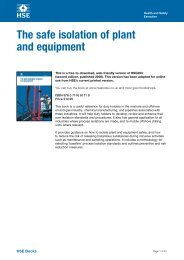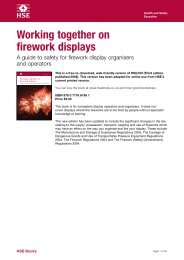Commercial diving projects inland/inshore - Health and Safety ...
Commercial diving projects inland/inshore - Health and Safety ...
Commercial diving projects inland/inshore - Health and Safety ...
You also want an ePaper? Increase the reach of your titles
YUMPU automatically turns print PDFs into web optimized ePapers that Google loves.
ACOP<br />
must be covered bythe risk assessment carried out under the<br />
Management of<strong>Health</strong> <strong>and</strong> <strong>Safety</strong> atWork Regulations 1999 orin any<br />
assessment required to becarried out under other specific regulations.<br />
Diving projectplan<br />
38 Based on this information,the <strong>diving</strong> projectplan must state how<br />
the hazards identified<strong>and</strong>risks assessed will be controlled. The <strong>diving</strong><br />
projectplan may includea <strong>diving</strong> contractor'sst<strong>and</strong>ard operating<br />
rules, includinggenericrisk assessments. All documentsshouldshow<br />
the date uponwhich theywere prepared. The<strong>diving</strong>projectplan<br />
should recordthe outcome ofthe planning carried outin preparing the<br />
risk assessment includingallinformation<strong>and</strong>instructionswhich, so<br />
far as is reasonably practicable,are necessary to protect the health <strong>and</strong><br />
safety ofall thosetakingpart in the <strong>diving</strong>project. It should also<br />
explain when<strong>and</strong>how reviews oftheplan, the divesite <strong>and</strong>the specific<br />
risk assessments should be conducted. The resultsofthe review will<br />
only need tobe recordedifthere has been a significant change.<br />
39 The <strong>diving</strong> projectplan must cover the generalprinciplesofthe<br />
<strong>diving</strong> techniquesto beused aswell as the needs oftheparticular<br />
operation.Itmust alsoprovide contingency proceduresfor any<br />
foreseeable emergency, includingretrievinginjured <strong>and</strong>/or<br />
unconscious divers from the water.<br />
40 Eachsupervisormust begiven a copy ofthat part ofthe <strong>diving</strong><br />
projectplan relevantto the<strong>diving</strong>operationthathe orshewill be<br />
supervising.<br />
41 Some examples ofhazards <strong>and</strong> risks are given in paragraphs<br />
42-72. However, this is not a complete list ofallhazards or all<br />
measuresneededto controlrisk <strong>and</strong> in specialcircumstances,or if<br />
certain contingencies arise, more stringentsafeguards may be needed.<br />
General<br />
Diving methods<br />
42 Diving methods <strong>and</strong>equipmentshouldbe determinedas part of<br />
the risk assessment.<br />
43 Diving usingsurface-suppliedbreathingapparatus is the<br />
preferred methodofcarryingout <strong>diving</strong> operationsunder this Code<br />
because itisconsideredto be the safest methodof<strong>diving</strong>forthevast<br />
majorityof<strong>diving</strong> operationscovered.<br />
44 The <strong>diving</strong> contractor should ensureas a minimumthat:<br />
(a) the diverwearsa full facemask which should be fittedwith either<br />
an oralnasal or amouthpiece;<br />
(b) the divercarries an independentsecondary sourceofbreathing<br />
gas (forexample, abail-out cylinder);<br />
(c) thereisa lifeline from the diver to thesurface. This should be<br />
tended.Twodivers connected byabuddy line need only be<br />
provided with one tended lifeline; <strong>and</strong><br />
6(2), 8(1),(3) (d) appropriatetwo-way communication with the diver is provided.<br />
11







